Qualcomm Intros Snapdragon X Plus, Details Complete Snapdragon X Launch Day Chip Stack
by Ryan Smith on April 24, 2024 9:15 AM ESTSnapdragon X Plus: Second Verse, A Bit Less Than the First
Alongside today’s announcement of the Snapdragon X chip SKUs and the Snapdragon X Plus branding, Qualcomm put together a short presentation on the Snapdragon X Plus. Given that the underlying hardware is identical to the Snapdragon X Elite, there’s not much to talk about here in terms of technology or technical specs.
But ahead of the mid-year hardware launch, Qualcomm is providing some fresh performance slides, comparing the Snapdragon X Plus to its current-generation competition from Intel and AMD, as well as Qualcomm’s own Snapdragon X Elite. As with all vendor-provided benchmarks, these should be taken with a grain of salt. But if nothing else, it’s notable here what Qualcomm is and isn’t saying.
With 10 high-IPC CPU cores, Qualcomm should fare well in multi-threaded workloads, and this is exactly what they’re opting to promote. According to the company, the Snapdragon X Plus has a significant edge in both performance and power consumption at iso-power and iso-performance respectively. In the case of Cinebench 2024MT, that’s a 28% performance advantage over the Core Ultra 7 155H, or matching that chip’s peak performance at 39% lower power consumption.
Notably, however, what you won’t find from Qualcomm is any material promoting Snapdragon X Plus’s single-threaded performance versus any competition. With those peak clockspeeds of 3.4GHz, the Plus isn’t in a very favorable position versus the 4.8GHz Core Ultra 7 155H, even with what is presumably an IPC advantage.
As far as Qualcomm’s own chips are concerned, the Elite understandably has the advantage at any point on the curve in these MT tests. For a given architecture, a larger number of CPU cores is always the more energy efficient options, never mind the Elite’s clockspeed advantage on top of that. In any case, Qualcomm’s own figures put the Plus at about 15% behind the flagship Elite in Geekbench, and around 20% behind in Cinebench.
The company is also touting an advantage in GPU performance. Though as the benchmark in question is 3DMark Wildlife Extreme, a bencehmark that Qualcomm has already optimized for forwards, backwards, and upside-down within their drivers, I’m more interested in seeing how more PC-exclusive workloads perform. Though to Qualcomm’s credit, they’re no stranger to that space either, as they’ve been shipping Windows-on-Arm Snapdragon SoCs for several years now.
Snapdragon X Plus: Live and In Person
Finally, alongside briefing the press on the Snapdragon X Plus, Qualcomm also had some devices using the new chip SKU to show off, demonstrating the performance of the chip. This setup was similar to Qualcomm’s Snapdragon Summit preview event for the Snapdragon X Elite in October, albeit a bit more free-wheeling and hands-on now that the hardware is a bit more mature and there’s less of a chance of something going awry.
As with that preview event, Qualcomm has equipped their own internal reference design laptops with the chips. With its lower performance, all of the Snapdragon X Plus systems were the “config B” system, which is Qualcomm’s thin-and-light reference design, sporting a 14.5-inch OLED screen and designed for a total system TDP of 23 Watts.
| Qualcomm Snapdragon X Reference Test Systems (Thin and Light) | ||
| AnandTech | Snapdragon X Elite (X1E-80-100) |
Snapdragon X Plus (X1P-65-100) |
| 2 Core Max Turbo | 4.0GHz | 3.4GHz |
| All Core Max Turbo | 12C @ 3.4GHz | 10C @ 3.4GHz |
| GPU | 3.8 TFLOPS | 3.8 TFLOPS |
| RAM | LPDDR5X-8448 | LPDDR5X-8448 |
| Display | 14.5-inch OLED 2880x1800 |
14.5-inch OLED 2880x1800 |
| Thickness | 15mm | 15mm |
| Device TDP | 23W | 23W |
| Cooling | Active | Active |
| Battery | 58Wh | 58Wh |
The Elite version of this laptop was running the X1E-80-100 chip (the same chip as last time) which features a reduced performance GPU, a peak dual-core CPU clockspeed of 4.0GHz, and an all-core turbo of 3.4GHz. Meanwhile the Plus system has an identical GPU and all-core turbo clockspeed, but only 10 CPU cores with a peak dual-core CPU clockspeed of 3.4GHz.
As before, these systems were pre-configured with major benchmarks selected by Qualcomm, including Geekbench 6.2, Cinebench 2024, UL Proycon, PCMark 10, 3DMark, Blender, and new-to-Windows-on-Arm, Chrome. Qualcomm did let us touch these machines this time around, but these demos are still primarily being hosted to prove that Qualcomm is achieving the performance figures they claim.
On that note, here’s a quick rundown of Qualcomm’s performance claims, and what we observed for the Plus in action.
| Qualcomm Snapdragon X Benchmark Scores (Thin and Light) | ||||
| AnandTech | Elite - QC Expected Range | Plus - Observed | Plus - QC Expected Range | Plus vs Elite Performance |
| Cinebench 2024 ST | 121-123 | 109 | 107-109 | 89% |
| Cinebench 2024 MT | 920-980 | 860 | 825-845 | 86% |
| Geekbench 6.2 ST | 2750-2800 | 2420 | 2400-2425 | 87% |
| Geekbench 6.2 MT | 14200-14400 | 13049 | 12800-13100 | 91% |
| Chrome - Speedometer 2.1 | 450-470 | 426 | 410-430 | 91% |
| Chrome - JetStream 2.1 | 310-320 | N/A | 280-290 | 91% |
| PCMark 10 Applications | 12800-13200 | N/A | 12500-12800 | 97% |
| UL Procyon - Office Productivity | 6200-6500 | N/A | 5700-5900 | 91% |
| UL Procyon - AI CV Inference | 1750-1800 | N/A | 1750-1800 | 100% |
| 3DMark Wildlife Extreme | 37.1-38.5 fps | 37.1 | 37.1-38.5 fps | 100% |
| Blender (CPU) | 380-410 | N/A | 340-360 | 88% |
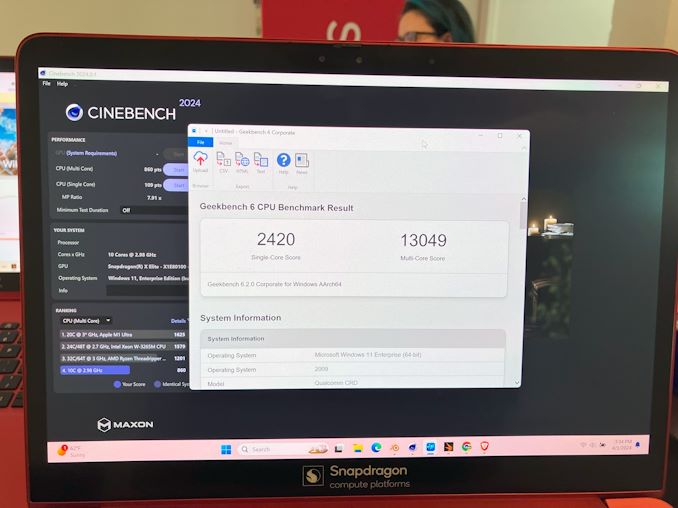
Geekbench 6.2 & Cinebench 2024
And with a little hands-on time, I even convinced Qualcomm’s representative to run the newer Speedometer 3.0 test on Chrome, which has just come out and was not yet part of their official benchmark suite. It scored 22.8.
Notably, here, the Snapdragon X Plus is closer in performance than what clockspeeds alone would predict. In Qualcomm’s supplied benchmark results, the Plus is never more than 14% behind in multithreaded workloads, and 13% behind in single-threaded workloads. And most of the time, it’s a 10% difference or less.
The 23 Watt system-wide TDP limit of the Qualcomm reference system is relatively constraining, all things considered. So I would not be the least bit surprised if the Snapdragon X Elite is being held back, in part, by not being able to run faster within Qualcomm’s systems. In other words, this is a more real-world test, as opposed to testing peak-to-peak unbounded by TDP concerns.
Overall, I don’t know if anything presented with the Snapdragon X Plus thus far would be considered all that surprising. With Qualcomm making their biggest push into the PC market yet, it makes perfect sense that they’re introducing multiple SKUs – and that they’d need some kind of branding to differentiate them. And while the Plus obviously won’t deliver the kind of chart-topping highs that the Elite will, it’s still based on all the same hardware that Qualcomm is banking on to make their reset PC ambitions a success. So like the rest of the Snapdragon X family, I’m looking forward to seeing what the hardware – Oryon CPU cores and all – can deliver when it launches in the middle of this year.


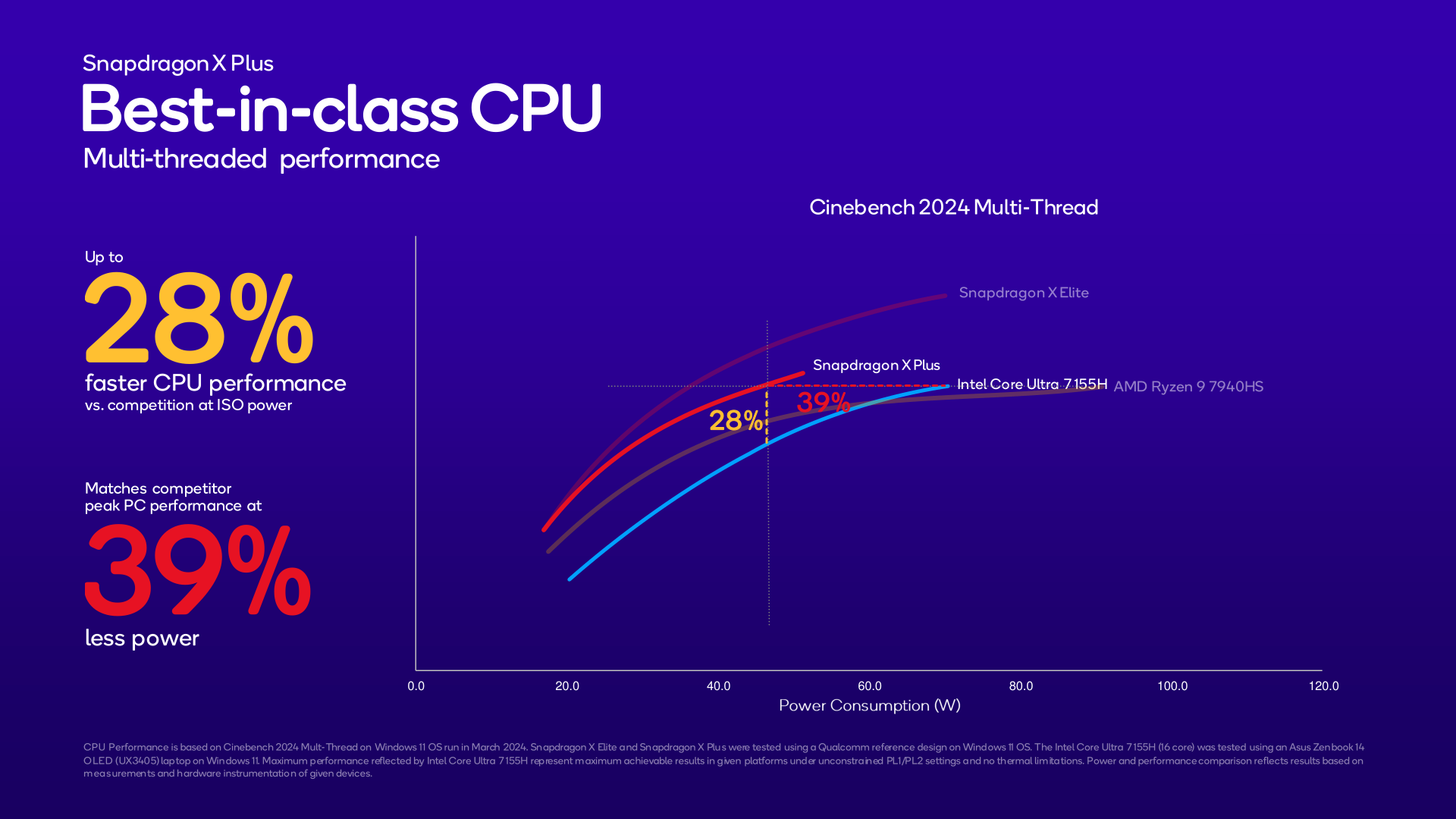
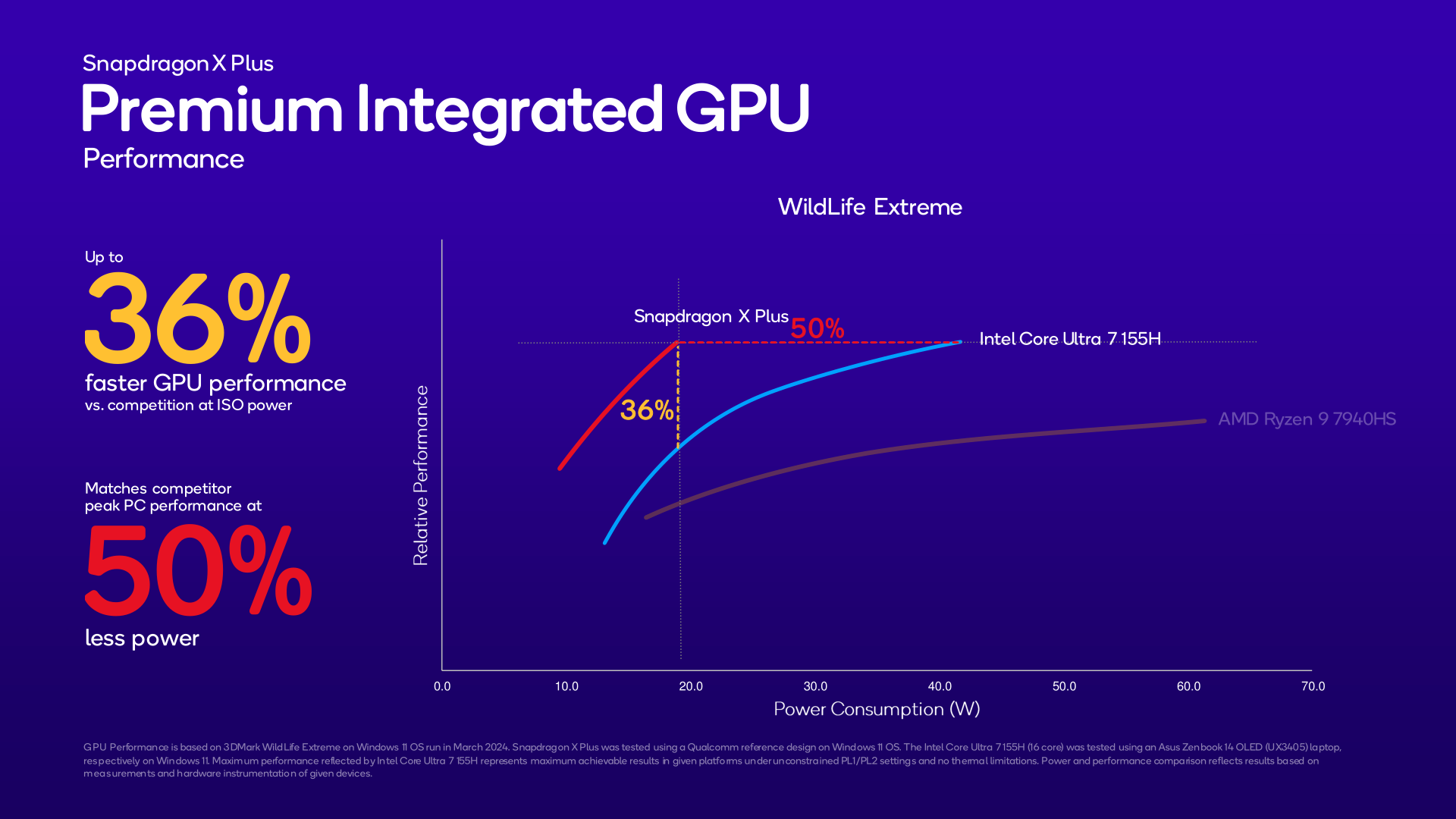
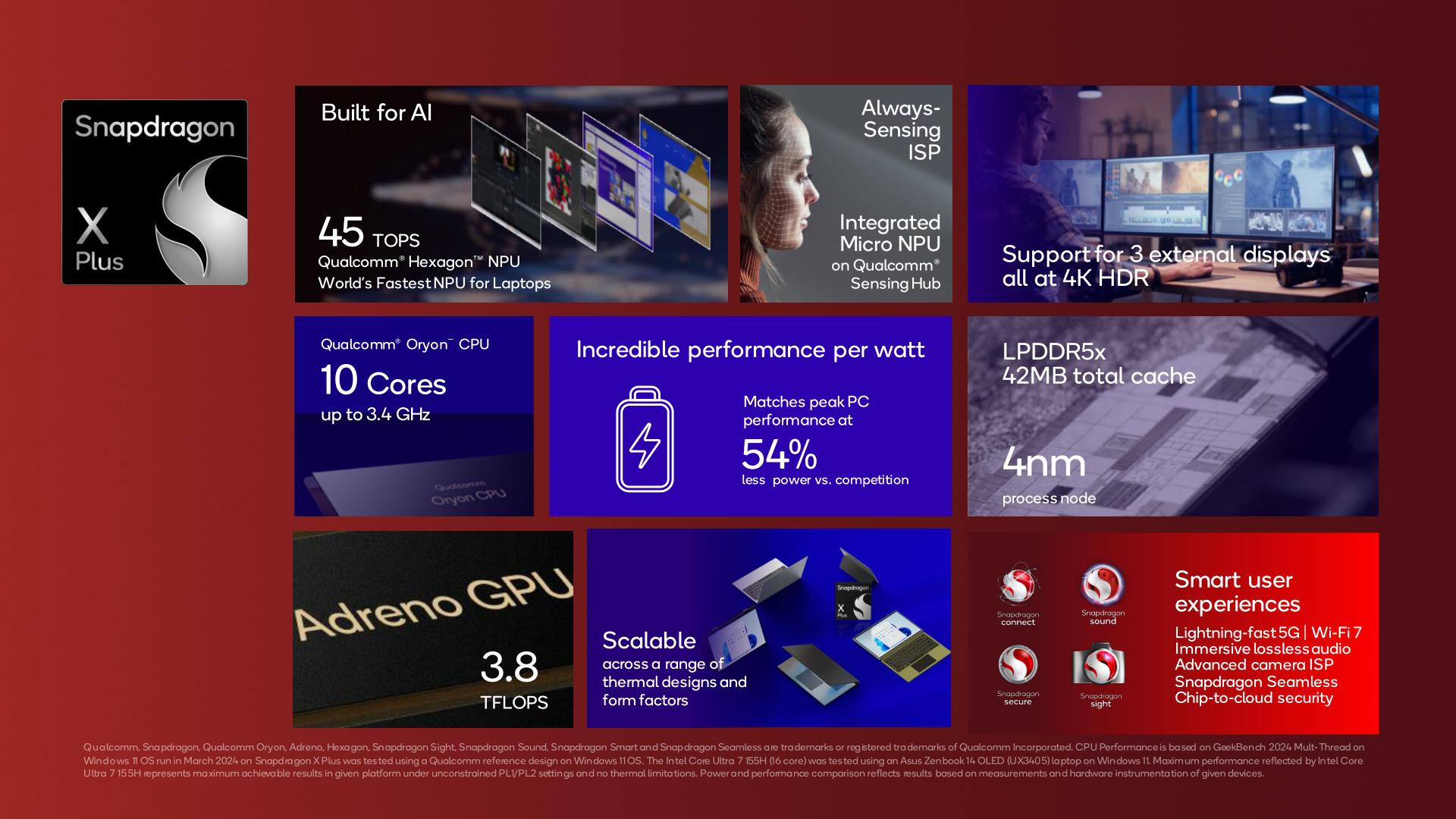






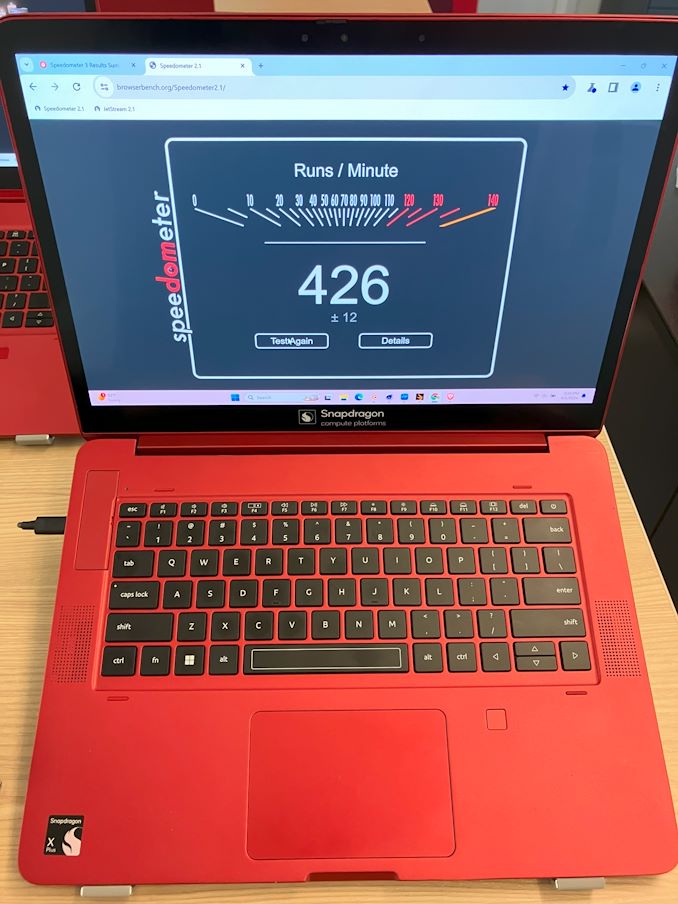
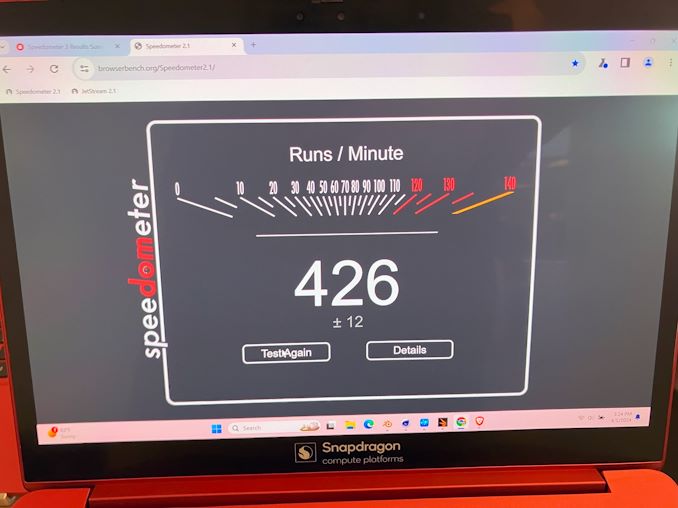
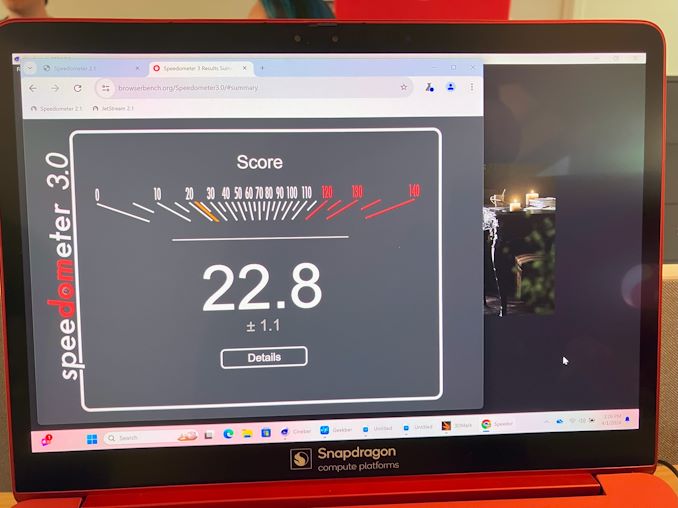









50 Comments
View All Comments
Hifihedgehog - Thursday, April 25, 2024 - link
No, it’s not. Charlie is just salty he isn’t the center of attention in the industry anymore and that he didn’t get a first look at Snapdragon X like the rest of the tech sites did. Some journalists have overinflated egos of themselves and Charlie is among the worst kind of that ilk. Replygarblah - Wednesday, April 24, 2024 - link
I wonder how good real time encoding quality of AV1 can be on mobile hardware in 2024. I guess if they weren't achieving better quality at a given bitrate than h.265 then they wouldn't include it just to check a box on a feature list, right? ReplyGeoffreyA - Thursday, April 25, 2024 - link
With AV1, it's quite easy to beat HEVC, so I suppose it will be better. In software encoding, SVT-AV1, using the fastest preset, has better compression and speed than x265 and even x264. I can't remember which presets exactly, but I think medium. I'll give it a test and confirm.What would be nice to see is VVC encoding and decoding, playback having been widely enabled of late by FFmpeg's new decoder. Reply
tipoo - Wednesday, April 24, 2024 - link
A big question will be what cost systems these will be in. Will they have lower margins on the chip than AMD and Intel as ARM SoCs typically do, or will they try to move up in the world? The Plus still looks like plenty of performance, could have a lot of appeal if it brings similar perf/watt to M3 in much lower cost systems Replyikjadoon - Wednesday, April 24, 2024 - link
Very curious what happened with the LPDDR5 frequency. Supplier change? Some esoteric reference clock was set too high? Picking a non-JEDEC-standard # isn’t bad or even very interesting, but it certainly makes you curious of the engineering why.//
Still feels weird to tease a CPU this early with so much first-party specific data, but little on the technical side. Like, surely, if QC knows all this, then popular details about the uArch or GPU config or cache would be set in stone.
I also don’t love the names. Are all the Elite versions seriously going to use obscure product codes to differentiate? 😭 So Elite X 84, Elite X 80, etc.?
No Elite Xa, Elite Xb, etc?
Whatever happened to those 3.2K Geekbench 6.2 1T results? Are those gone forever now? I don’t seen them mentioned anymore. Reply
Ryan Smith - Wednesday, April 24, 2024 - link
"Whatever happened to those 3.2K Geekbench 6.2 1T results? Are those gone forever now? I don’t seen them mentioned anymore. "The current guidance from Qualcomm for GB 6.2 ST performance is to expect a high TDP (config A) system to score between 2850 and 2900. The previous guidance in October was 2939-2979. Reply
ikjadoon - Wednesday, April 24, 2024 - link
Ah, interesting, right. So there has been a small drop off.//
I was actually remembering these Qualcomm benchmarks from also October 2023:
Geekbench 6.2 1T
Qualcomm "Oryon" (no SXE name): 3,227
Intel i9-13980HX: 3,192
Apple M2 Max: 2,841
https://www.pcworld.com/article/2112907/qualcomm-s...
It's not a major regression, but I do wonder where the 3.2K number came from, if it was also released around the Oct 2023 timeframe. Reply
Ryan Smith - Wednesday, April 24, 2024 - link
Ahh, you're thinking about the Geekbench Linux results.The high TDP systems running Linux score a bit higher than the Windows systems, due to a combination of OS differences and the fact that (at the time) there was no speed management for the fans - so they were locked at 100%. We observed a demo system scoring 3236, and there had apparently been runs that were faster.
https://www.anandtech.com/show/21112/qualcomm-snap... Reply
trivik12 - Wednesday, April 24, 2024 - link
I am looking forward to independent reviews on laptops with these chips but its annoying around trickled info that is coming out. Replysnakeeater3301 - Wednesday, April 24, 2024 - link
I think Snapdragon X in any way or form has high probability of flopping it's because of the graphics driver support for decades and decades of many applications especially gaming just wouldn't be there and they have to continuously update them every time and an important game is released. Also what about all the really important rendering applications there is a very high barrier to entry in the pc space. Reply